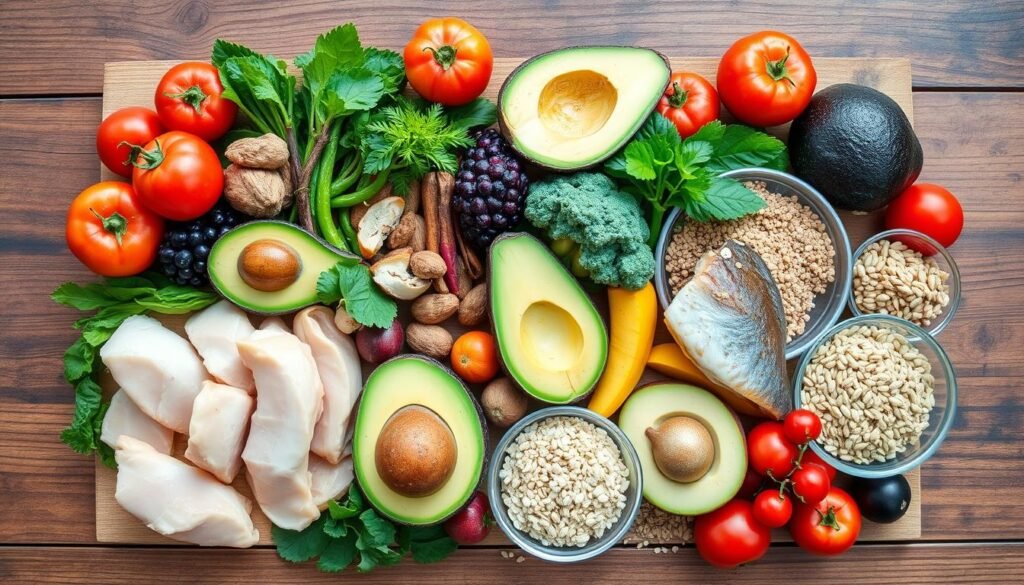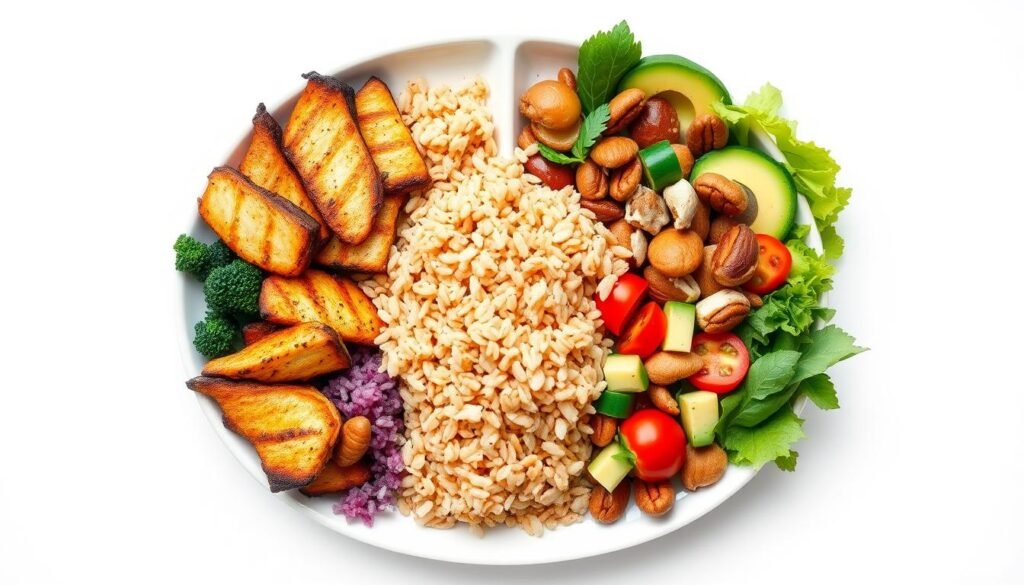Did you know the average American eats about 3,600 calories a day? This is way more than the 2,000-2,500 calories most experts say we should eat. Yet, many people still find it hard to lose weight and stay healthy. The key to losing weight might not be just cutting calories. It could be about knowing how important macronutrients – protein, carbs, and fats – are.
Macronutrients give us energy, and learning how to use them can help us lose weight. By choosing the right foods and balancing our macros, we can eat fewer calories without feeling hungry or tired. This way, we can lose weight and feel good doing it.
Everything You Need to Know Before Counting Macronutrients for Weight Loss,

Key Takeaways
- Macronutrients (protein, carbohydrates, and fats) are essential for providing the body with energy and supporting various physiological functions.
- Manipulating macronutrient intake can lead to modest weight loss and improvements in heart disease risk factors.
- Incorporating a balance of nutrient-dense, high-fiber carbs, lean proteins, and healthy fats can aid in weight loss efforts by promoting satiety and muscle preservation.
- Counting macros may help individuals make more nutritious food choices and maintain a calorie deficit without feeling deprived.
- Consulting a registered dietitian is recommended to ensure individual macronutrient needs are met and the diet is appropriate for one’s health and fitness goals.
What Are Macronutrients and Their Role in Weight Management
Macronutrients are the three main nutrients our bodies need a lot of: protein, carbohydrates, and fats. These nutrients are key for staying healthy and helping with weight control.
Key Functions of Macronutrients in the Body
Carbohydrates are our brain’s top energy source. Proteins help our bodies grow, repair, and stay strong. Fats give us energy, help cells work right, protect organs, and support hormone and vitamin use.
How Macros Affect Weight Loss Goals
Macros play a big part in how full we feel, our metabolic rate, and muscle recovery. The right mix of macros can help with losing weight by controlling hunger, energy use, and body shape.
The Science Behind Macro Balance
Studies show that the right macro balance can help with weight loss. The Dietary Guidelines for Americans 2020–2025 say we should get 45–65% of our calories from carbs, 10–35% from protein, and 20–35% from fats.
Knowing how to balance macros is key for a lasting weight management plan. Eating nutrient-rich, whole foods helps us stay in a calorie deficit while keeping our health in check.
The Connection Between Calories and Macronutrients for Weight Loss
Macronutrient balance is key, but calorie intake is more important for losing weight. A calorie deficit is needed to lose weight, no matter the macronutrient mix. Proteins and carbs have 4 calories per gram, while fats have 9. Knowing this helps in making good weight loss plans that look at both calories and macronutrients.
To lose weight, you need to eat fewer calories and move more. But, people often don’t know how many calories they eat. They might underestimate by up to 20%, and overweight people by up to 40%. This shows why it’s crucial to track calories and macronutrients accurately for a successful weight loss plan.
Experts say a 20% calorie deficit is good for losing weight. For healthy adults, the best macronutrient mix is 45-65% carbs, 20-35% fats, and 10-35% proteins. Changing these ratios based on your needs can help you lose weight more effectively.
“Sustainable weight loss requires a focus on both calorie intake and macronutrient balance, as they work together to create the necessary energy deficit for fat loss.”
Protein: The Essential Macro for Fat Loss
Protein is key for losing weight. It makes you feel full, boosts your metabolism, and keeps your muscles strong. This is important for a healthy body. Aim for 1.2-2 grams of protein per kilogram of your weight for the best results. Eating lean protein can help you reach your fat loss goals.
Best Sources of Lean Protein
Choosing the right protein is vital for weight loss. Lean meats like chicken, turkey, and some beef are great. Fish and seafood, such as salmon and shrimp, are also good choices. Low-fat Greek yogurt, cottage cheese, and eggs are great for protein too.
For those who don’t eat meat, legumes, tofu, tempeh, and quinoa are excellent options.
Protein’s Role in Muscle Preservation
Keeping your muscles while losing weight is important. It helps keep your metabolism high and your body toned. Eating enough protein and doing strength training helps prevent muscle loss. This makes it easier to lose weight and keep it off.
| Macronutrient | Recommended Intake for Weight Loss |
|---|---|
| Protein | 1.2-2 grams per kilogram of body weight |
| Carbohydrates | 30-50% of total calories |
| Fat | 20-30% of total calories |
Eating a balanced diet rich in protein and doing strength training helps with weight loss. It also keeps you healthy and toned.
“Protein is essential for weight loss, as it helps keep you feeling full and satisfied, while also preserving muscle mass – a key factor in maintaining a healthy metabolism.”
Remember, the best macronutrient mix for weight loss varies. It’s important to find what works for you and your lifestyle.
Understanding Healthy Fats for Weight Management
Healthy fats are key for managing weight. They are one of the main nutrients we need. The right fats can help you lose weight. Good fats, like monounsaturated and polyunsaturated, can lower bad cholesterol and heart disease risk.
Bad fats, like trans fats, do the opposite. They raise bad cholesterol and lower good cholesterol, increasing heart disease risk.
Adding healthy fats to your diet can help you feel full and prevent overeating. They also help lower bad cholesterol, improving your health.
To get the most from healthy fats, eat whole foods. Choose fresh foods over processed ones to cut down on bad fats. The right mix of omega-3 and omega-6 fats is also good for your heart.
Healthy fats are good for more than just weight loss. They also help your skin, hormones, and vitamin absorption. Eating the right fats can bring many benefits beyond weight loss.
For effective weight management, balance your diet with healthy fats. Aim for 20-30% of your calories to come from fats.
Understanding healthy fats and adding them to your diet can help you reach your health goals. It’s important to track your fat intake for success.

“Healthy fats can play a crucial role in weight management, providing essential nutrients and supporting overall health and well-being.”
Complex Carbohydrates vs. Simple Sugars
Carbohydrates are key for our bodies, but not all carbs are the same. Complex carbs, found in whole grains, veggies, and legumes, are better for losing weight than simple sugars. They digest slowly, releasing glucose into the blood gradually. Simple carbs, found in processed foods, raise blood sugar levels quickly.
Impact on Blood Sugar and Weight Loss
Carbs affect blood sugar levels, which is important for losing weight. Complex carbs, rich in fiber and starch, help keep blood sugar stable. Simple sugars, on the other hand, can cause blood sugar and insulin to spike, leading to hunger and overeating. Eating more complex carbs can help control weight and blood sugar, great for those with type 2 diabetes.
Choosing the Right Carb Sources
It’s crucial to pick the right carbs. Complex carbs, like those in fruits, veggies, nuts, and whole grains, offer essential nutrients and fiber. Simple carbs, like sugars, should be limited because they lack nutritional value. Foods like quinoa and whole wheat are great for fiber and nutrients, while potatoes and oats are complex carbs.
Choosing complex carbs and limiting simple sugars supports weight loss and a balanced diet. The American Heart Association suggests limiting added sugar to 25 g (6 teaspoons) for women and 36 g (9 teaspoons) for men. A balanced diet, including carbs, is key for health.
“Complex carbohydrates are crucial for stable blood sugar levels and longer-lasting fullness, while simple sugars can lead to spikes and crashes that contribute to weight gain.”
| Complex Carbohydrates | Simple Sugars |
|---|---|
| Found in whole grains, vegetables, and legumes | Found in processed foods and sweets |
| Digest and release glucose slowly | Spike blood sugar levels rapidly |
| Provide sustained energy and feelings of fullness | Can contribute to increased hunger and overeating |
| Recommended for weight loss and diabetes management | Should be limited for optimal health and weight |
Knowing the difference between complex carbs and simple sugars helps you make better choices for weight loss and health.
Creating a Sustainable Macronutrient Balance
Getting the right balance of macronutrients is key for lasting weight loss. Most adults should aim for 45-65% of calories from carbs, 20-35% from fat, and 10-35% from protein. But, your exact needs can change based on your age, gender, how active you are, and any health issues.
Trying out different macronutrient ratios can help find what works best for you. Eating nutrient-rich, whole foods is essential for health and weight loss. Counting macros can help ensure you get enough protein, which can make you feel full and cut down on cravings. Yet, counting macros might not be right for everyone, like those with certain health needs or trouble tracking their food.
First, figure out how many calories you need, then use the AMDR percentages to set your macronutrient goals. To do this, multiply your calories by 0.4 for carbs and protein, and by 0.2 for fat.
“For a successful weight-loss regimen, portion size and frequency of meals are crucial factors to consider when counting macros.” – Dr. Laing
Planning your meals ahead can help you stay on track with a balanced diet when counting macros. How active you are and your body goals will affect how flexible your macronutrient ratios can be.

Choose lean proteins like chicken, turkey, fish, grass-fed beef, eggs, and legumes when counting macros. Getting advice from a registered dietitian can help tailor your macronutrient ratios to fit your unique needs.
Macronutrients for Weight Loss: Finding Your Ideal Ratio
Finding the right macronutrient ratio is key to losing weight. You need to figure out your personal macro needs. This depends on your body type, how active you are, and how much weight you want to lose.
Calculating Personal Macro Needs
First, use tools like the NIH Body Weight Planner to guess your daily calorie needs. Then, split those calories into proteins, fats, and carbs. Aim for 10-35% protein, 20-35% fat, and 45-65% carbs.
The USDA says you should get 45%-65% of your calories from carbs, 20%-35% from fats, and 10%-35% from protein. For losing weight, a good mix is 30%-40% carbs, 20%-30% fats, and 25%-35% protein.
Adjusting Ratios for Different Goals
Weight loss ratios can vary a lot. Some say eat more protein and less carbs. Others recommend 5-15% carbs, 25-35% protein, and 45-65% fat for losing weight. A good starting point is 40% carbs, 30% proteins, and 30% fats. You might need to adjust these based on how you respond and your dietary needs.
Figuring out your ideal macro ratio takes time and trial and error. Keep checking and adjusting your macros as your weight loss goals change.
“For weight loss, a calorie deficit of about 500 calories per day is commonly recommended to achieve a weight loss of about one pound per week.”
To figure out your macros, divide your daily calories by the percentages to find out how many grams of carbs, proteins, and fats you need. Remember, the best ratio for you depends on your goals, activity level, age, health, and genetics.
By finding your personalized macro ratio, you can reach your weight loss goals and achieve lasting macro ratio success.
Common Mistakes in Macro Counting
Tracking macronutrients can help with weight loss, but there are pitfalls to watch out for. One big mistake is focusing too much on numbers without looking at food quality. Missing out on micronutrients and not adjusting macros as you lose weight are also common errors.
Getting the portion sizes wrong can lead to eating too much or too little, affecting your weight goals. Not counting fats added during cooking and forgetting to track drinks can also mess up your plan. Plus, natural changes in ingredients and wrong labels can cause up to a 20% difference in tracking.
Remember, hitting your macro targets is key, but so is the quality of your food. Eating whole, nutrient-rich foods can help you avoid these mistakes and achieve lasting weight loss.
FAQ
What are macronutrients and what is their role in weight management?
Macronutrients, or “macros,” are the three main nutrients that give us energy. They are protein, carbohydrates, and fats. The right mix of these can help with weight loss by controlling hunger, energy use, and body shape.
How do macronutrients function in the body?
Carbs are our brain’s top energy source. Proteins help grow, repair, and keep our body parts in good shape. Fats give us energy, help cells work, protect organs, and aid in vitamin and hormone use.
How do macronutrients affect weight loss goals?
They play a big role in feeling full, how fast we burn energy, and how our body responds to hunger hormones. The right mix can help with losing weight by controlling hunger, energy use, and body shape.
What is the connection between calories and macronutrients for weight loss?
While the balance of macros is important, the most key factor for losing weight is calorie intake. To lose weight, you need to burn more calories than you eat, no matter the macro ratio.
Why is protein crucial for weight loss?
Protein is key for losing weight because it keeps you full, boosts your metabolism, and helps keep muscle mass. Eating 1.2-2 grams of protein per kilogram of body weight is best for losing weight and keeping muscle.
How do healthy fats support weight management?
Healthy fats, like monounsaturated and polyunsaturated fats, help with weight loss by controlling energy use and hunger. Omega-3 fatty acids are linked to losing weight and keeping muscle.
What is the difference between complex and simple carbohydrates, and how do they affect weight loss?
Complex carbs, found in whole grains, veggies, and legumes, are better for weight loss. They give lasting energy and make you feel full. Simple sugars in processed foods can cause quick blood sugar spikes, leading to hunger and overeating.
How can I create a sustainable macronutrient balance for long-term weight loss success?
For lasting weight loss, finding a balance that works for you is key. Consider your age, gender, activity level, and health when setting your macro balance. Try different ratios to find what works best for you.
How do I find my ideal macronutrient ratio for weight loss?
Start by figuring out your daily calorie needs with tools like the NIH Body Weight Planner. Then, split those calories into macros: 10-35% protein, 20-35% fat, and 45-65% carbs. You might need to adjust these ratios to get the best results and stick to your diet.
What are some common mistakes in macro counting for weight loss?
Mistakes include focusing too much on numbers without looking at nutrient density, ignoring micronutrients, and not adjusting macros as you lose weight. Other errors include wrong portion sizes, not accounting for added fats from cooking, and forgetting to track drinks. It’s important to focus on whole, nutrient-rich foods for lasting success.
Source Links
- Everything You Need to Know Before Counting Macros for Weight Loss, Per Experts – https://www.prevention.com/weight-loss/diets/a19804935/macros-diet/
- What is the macro diet? – https://www.bbcgoodfood.com/health/special-diets/what-is-the-macro-diet
- The Best Macronutrient Ratio for Weight Loss – https://www.healthline.com/nutrition/best-macronutrient-ratio
- Mastering Your Macros: A Comprehensive Guide to Weight Loss – https://myhummusfit.com/blogs/news/calculating-weight-loss-macros?srsltid=AfmBOoqbbacNuBN8d-VfNsEkJiTk2aQAAihveQ-MDtsU9A8T0p6O7y5J
- Nutrition: Macronutrient Intake, Imbalances, and Interventions – StatPearls – https://www.ncbi.nlm.nih.gov/books/NBK594226/



